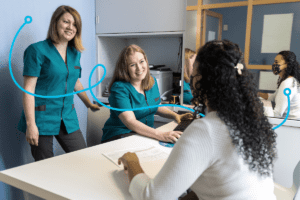Looking at the Patient Experience
There are a lot of conversations about what makes for a good patient experience. Certainly, we know that your patients want to feel respected by your staff. We know that they anticipate a good oral healthcare outcome.
But what does that journey truly look like from start to finish? What happens at each step of the way? And where does your patient even begin?
In this blog, we’ll go on this journey with you to see how the patient experience unfolds at every step.
How Your Patient Begins

Every patient’s experience starts in the same place: with a dental issue that they need resolved. It’s important to acknowledge this because it gives a sense of how high the stakes are. Dental health is not covered under universal health insurance in Canada and is not guaranteed to be covered under extended health. In the United States, dental care is usually not covered under state health care or is an add-on to most health insurance plans. For both the patient’s health and the patient’s pocketbook, the stakes are already high before they even begin their journey with your practice.
Maybe, like many prospective patients, they haven’t been to the dentist in a few years. They have to find your practice.
This is where patient reviews come in. Consumers use online reviews to choose businesses, healthcare options, and more. Google reviews, in particular, are very powerful, because they can boost you in the Google algorithm. Since most consumers use Google as their preferred search engine, being boosted in this algorithm means that your prospective patients are more likely to find you. We’ll come back to this at the end of the patient journey.
But, for that prospective patient, they have read reviews, done some research, and found your practice.
Depending on the type of procedure needed, of course, it’s possible that your patient will be referred by either their family doctor. Or, if they require the attention of a dental specialist of some kind, they may be referred to your practice by their usual dentist.
Now, your patient has made contact with your practice. This is your opportunity to begin to offer them a great patient experience and a great oral healthcare outcome.
Getting Your Patients to Your Practice
One thing to bear in mind about the patient experience is convenience. Of course, there is important information that you have to gather from your patient. But, patients and consumers are the same groups of people. Your patient is constantly experiencing other types of customer service that are built for their convenience.
For example, when they go to the barber or to the nail salon, they will receive information by their preferred method of communication. Often, this is by text message. They will be told where and when they need to go, how to come prepared, what kind of parking options they can expect when they get there, and more. It is becoming more and more common for patients to expect this from their healthcare providers.
With this in mind, let’s look at the first point of contact with your practice. This is where their patient experience will begin.
The patient journey always begins with an intake form and medical history. If possible, customizing these by appointment type will improve the patient experience. For example, you do not need to know about underlying heart conditions if your patient is only coming in for a teeth cleaning! As much as possible, only ask the questions that are relevant to them. This shows your patients that you value their time.
Utilizing patient communication software is helpful here. Sending these important forms by email, with a user-friendly interface, is often more convenient for your patient. They don’t have to remember to bring hard copy forms back to your practice. It also benefits your staff, avoiding any miscommunications because the patient’s handwriting was hard to read!
The next part of the patient experience is a key moment: the initial consultation, when your patient comes into your practice for the first time!
At the Practice

An integral part of the patient experience is supporting your patients in coming to the initial consultation prepared. This sets you both up for success. This is where appointment reminders come in. If possible, you can automate these reminders, making it a lot easier for your staff!
At the initial consultation is when the patient experience truly goes ‘live’, in the sense the patient is face-to-face with you for the first time. This is your opportunity to show what kind of culture you have created at your office.
As we examined in this blog earlier in the year, an essential part of the patient experience is establishing trust. Cultivating that trust and showing your patient that you care are the most important parts of the patient’s experience. The initial consultation is when you begin to establish that trust.
After the initial consultation, your patient will be able to book their procedure. Here, the patient experience shifts to keeping the patient engaged remotely. You will need to create a messaging cadence that is specific to the patient. Some factors to consider are:
- What reminders does the patient need? Do they need to take medication before the appointment? Does their procedure require fasting?
- What further forms does the patient need to fill out? Are there any waivers, for example? Or were you hoping to use any photographs of the procedure on your website?
- Any special directions that might be necessary for getting to your practice, such as a link to Google Maps or similar can be helpful here. Is parking challenging to find, for example?
Incorporating these reminders into your messaging cadence supports your patient. It improves their experience because they are more likely to come to your office prepared. It shows that you value their patient experience. You care about their time and their business.
The Cycle Continues
Once the procedure has been completed, the most important part of the patient experience is ensuring that oral health care outcome. Often, after-care or follow-up care is part of that experience.
This looks different, of course, depending on the procedure. For something like a routine teeth cleaning, it would be silly to send a reminder to book a follow-up appointment for the following week! However, for dental surgery, supporting the patient with both after-care and follow-up care is an important part of the equation.
This is, again, where reminders become an important part of the patient experience. Your patients want to know that you value their time and health. When this comes to after-care, your patient will want the instructions readily available. Often, hard-copy instructions are harder to manage, partly because they are easier to lose. Sending your patient after-care instructions by text or email allows them to have ready access.
If your patient needs to book a follow-up appointment, sending them an easy booking link by email or text can make this very user-friendly.
Once your patient has completed their appointment and follow-up experience with your practice, it’s a great time to ask for feedback and/or a review. Asking for a review is yet another way to show your patients that you care about their experience. This has a twofold benefit, in that:
- Patients get to communicate how you can improve. This facilitates an improved patient experience at your practice in the future.
- Patients get to communicate about how positive their experience was. Often this is something patients truly want to do!
As we saw earlier in the patient journey, online reviews are the way that many patients find their dental practice. The patient journey comes full circle. Your patients share their experiences and become advocates for your practice.
How Software Can Help the Patient Experience

Prioritizing the patient experience can be challenging for a dental practice. Certainly, the number of tasks that your staff has to do to give your patients a great experience can appear daunting.
Luckily, software like Intiveo’s can help with a lot of these tasks. Choosing a patient communication software can truly change the landscape of patient engagement. This kind of software allows you to get specific. You can give your patient an experience that is specific to them and their procedure. From appointment reminders to post-appointment instructions to requests for a Google review, Intiveo gives you the opportunity to automate your messaging.
Our features include:
- Software for both general dentistry and specialties, including OMS, periodontics, orthodontics, and more
- Product options for independent, multi-location, DSO, and academic clients
- Add-ons for forms, social reviews, and referral management
- Sending messages by text, email, or phone
- Customization of the messaging according to the patient’s appointment type
- Language options including English, Spanish, French, and Chinese languages
- A customer-facing team to support your staff with onboarding
Curious to learn more about Intiveo’s software? Book a meeting to learn more!
The Journey of Patient Engagement
Prioritizing your patients’ experience is key to the successful running of a practice. When your patients have a positive experience, they become your greatest advocates, bringing more patients into your practice. Plus, you get to deliver great oral healthcare outcomes knowing that your patients feel valued and supported by your practice.






